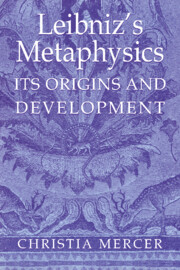Book contents
- Frontmatter
- Contents
- Acknowledgments
- References to Leibniz's works
- Introduction: first truths and half truths
- PART ONE METAPHYSICS OF METHOD
- 1 Eclecticism and conciliation, 1661–68
- PART TWO METAPHYSICS OF SUBSTANCE
- PART THREE METAPHYSICS OF DIVINITY
- PART FOUR METAPHYSICS
- Appendix I (Not exactly) First truths
- Appendix II Leibniz's original assumptions
- Bibliography
- Index Locorum
- Index
1 - Eclecticism and conciliation, 1661–68
from PART ONE - METAPHYSICS OF METHOD
Published online by Cambridge University Press: 12 March 2010
- Frontmatter
- Contents
- Acknowledgments
- References to Leibniz's works
- Introduction: first truths and half truths
- PART ONE METAPHYSICS OF METHOD
- 1 Eclecticism and conciliation, 1661–68
- PART TWO METAPHYSICS OF SUBSTANCE
- PART THREE METAPHYSICS OF DIVINITY
- PART FOUR METAPHYSICS
- Appendix I (Not exactly) First truths
- Appendix II Leibniz's original assumptions
- Bibliography
- Index Locorum
- Index
Summary
In the spring of 1661, at the age of fourteen, Leibniz began his university studies in Leipzig, where he came under the influence of the well-known German humanist, Jakob Thomasius. At the end of the decade, in the spring of 1669, he composed a long letter to Thomasius in which he presented for the first time in detail his most basic methodological and metaphysical assumptions. Between the years 1661 and 1669, Thomasius acted as the single greatest influence on Leibniz's philosophical development. It was from Thomasius that the brilliant young student acquired a commitment to a historically based conciliatory eclecticism, a belief in the soundness of the Aristotelian philosophy, and a familiarity with Platonism. Leibniz differed from his mentor on many points and went well beyond him on others, but throughout his life he remained convinced of the main philosophical lessons learned in Leipzig.
One of the central theses of this book is that the methodological and metaphysical commitments that Leibniz developed during his youth form the bedrock of his philosophy. There are two distinct parts to his method. The key to understanding Leibniz's thought in the 1660s (and much of what he did later) is to recognize that he practised a form of conciliatory eclecticism that fostered the accumulation and consideration of a wide variety of diverse ideas, that assumed an underlying truth beneath the various conflicting schools, and whose only stipulation was that the resulting collection be made consistent with Christian doctrine.
- Type
- Chapter
- Information
- Leibniz's MetaphysicsIts Origins and Development, pp. 23 - 60Publisher: Cambridge University PressPrint publication year: 2001



